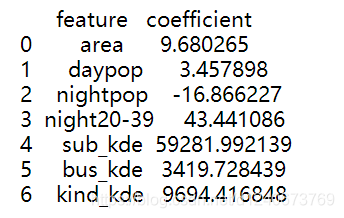用sklearn实现各种线性回归模型,训练数据为房价预测数据,数据文件见https://download.csdn.net/download/d1240673769/20910882
加载房价预测数据
import pandas as pd
df = pd.read_csv('sample_data_sets.csv') # 房价预测数据
print(df.columns)
df.head()

制作标签变量
# 制作标签变量
price_median = df['average_price'].median() # 房价中位数
print(price_median)
# 定义一个是否是高房价标签(大于中位数为高房价)
df['is_high'] = df['average_price'].map(lambda x: True if x>= price_median else False)
print(df['is_high'].value_counts())

提取自变量和因变量
# 提取自变量
x_train = df.copy()[['area', 'daypop', 'nightpop',
'night20-39', 'sub_kde', 'bus_kde', 'kind_kde']]
# 提取因变量:数值型
y_train = df.copy()['average_price']
# 提取因变量:类别型
y_label = df.copy()['is_high']
线性回归模型
# 加载pipeline
from sklearn.pipeline import Pipeline
# 加载线性回归模型
from sklearn.linear_model import LinearRegression
# 构建线性回归模型
pipe_lm = Pipeline([
('lm_regr',LinearRegression(fit_intercept=True)) # fit_intercept=True 表示拟合截距值
])
# 训练线性回归模型
pipe_lm.fit(x_train, y_train)
# 使用线性回归模型进行预测
y_train_predict = pipe_lm.predict(x_train)
# 查看线性回归模型特征参数
print(pipe_lm.named_steps['lm_regr'].coef_)
# 查看线性回归模型截距值
print(pipe_lm.named_steps['lm_regr'].intercept_)

# 提取模型特征参数
coef = pipe_lm.named_steps['lm_regr'].coef_
# 提取对应的特征名称
features = x_train.columns.tolist()
# 构建参数df
coef_table = pd.DataFrame({'feature': features, 'coefficient': coef})
print(coef_table)

# 加载画图组件matplotlib
import matplotlib.pyplot as plt
# 绘制参数特征值柱状图
coef_table.set_index(['feature']).plot.barh()
# 设置x等于0的参考线
plt.axvline(0, color='k')
# 显示图表
plt.show()

# 绘制参数特征值柱状图
coef_table.set_index(['feature']).iloc[0:4].plot.barh()
# 设置x等于0的参考线
plt.axvline(0, color='k')
# 显示图表
plt.show()

lasso线性回归模型
# 加载lasso回归模型
from sklearn.linear_model import Lasso
# 构建线性回归模型
pipe_lasso = Pipeline([
('lasso_regr',Lasso(alpha=500, fit_intercept=True)) # alpha控制L1正则系数的约束值
])
# 训练线性回归模型
pipe_lasso.fit(x_train, y_train)
# 使用线性回归模型进行预测
y_train_predict = pipe_lasso.predict(x_train)
# 查看线性回归模型特征参数
print(pipe_lasso.named_steps['lasso_regr'].coef_)
# 查看线性回归模型截距值
print(pipe_lasso.named_steps['lasso_regr'].intercept_)

如上图:后三个特征值的参数被约束到0
# 提取模型特征参数
coef = pipe_lasso.named_steps['lasso_regr'].coef_
# 提取对应的特征名称
features = x_train.columns.tolist()
# 构建参数df
coef_table = pd.DataFrame({'feature': features, 'coefficient': coef})
print(coef_table)

coef_table.set_index(['feature']).plot.barh()
# 设置x等于0的参考线
plt.axvline(0, color='k')
# 显示图表
plt.show()

ridge线性回归模型
# 加载ridge回归模型
from sklearn.linear_model import Ridge
# 构建ridge回归模型
pipe_ridge = Pipeline([
('ridge_regr',Ridge(alpha=500, fit_intercept=True, solver = 'lsqr')) # solver为求解器,lsqr表示最小二乘法
])
# 训练ridge回归模型
pipe_ridge.fit(x_train, y_train)
# 使用ridge回归模型进行预测
y_train_predict = pipe_ridge.predict(x_train)
# 查看ridge回归模型特征参数
print(pipe_ridge.named_steps['ridge_regr'].coef_)
# 查看ridge回归模型截距值
print(pipe_ridge.named_steps['ridge_regr'].intercept_)

# 提取模型特征参数
coef = pipe_ridge.named_steps['ridge_regr'].coef_
# 提取对应的特征名称
features = x_train.columns.tolist()
# 构建参数df
coef_table = pd.DataFrame({'feature': features, 'coefficient': coef})
print(coef_table)

coef_table.set_index(['feature']).plot.barh()
# 设置x等于0的参考线
plt.axvline(0, color='k')
# 显示图表
plt.show()

logstic回归模型
# 加载logstic回归模型
from sklearn.linear_model import LogisticRegression
# 构建线性回归模型
pipe_logistic = Pipeline([
('logistic_clf',LogisticRegression(penalty='l1', fit_intercept=True, solver='liblinear'))
])
# 训练线性回归模型
pipe_logistic.fit(x_train, y_label)
# 使用线性回归模型进行预测
y_train_predict = pipe_logistic.predict(x_train)
逻辑回归模型参数解释:
penalty(默认使用l2正则系数)
- ‘l1’: l1正则系数,
- ‘l2’: l2正则系数
- ‘none’:无正则系数
solver(默认是’liblinear’:坐标下降法)
- ‘liblinear’:坐标下降法,可以处理了l1和l2正则系数,适用于小数据量(一般指10w个样本以下)
- ‘sag’:sag是随机平均梯度下降法,只能处理l2正则系数,适用于大数据量
- ‘saga’: saga是sag的变体,能处理l1和l2正则系数,适用于大数据量
# 查看逻辑回归模型特征参数
print(pipe_logistic.named_steps['logistic_clf'].coef_)
# 查看逻辑回归模型截距值
print(pipe_logistic.named_steps['logistic_clf'].intercept_)

# 提取模型特征参数
coef = pipe_logistic.named_steps['logistic_clf'].coef_[0]
# 提取对应的特征名称
features = x_train.columns.tolist()
# 构建参数df
coef_table = pd.DataFrame({'feature': features, 'coefficient': coef})
print(coef_table)

coef_table.set_index(['feature']).plot.barh()
# 设置x等于0的参考线
plt.axvline(0, color='k')
# 显示图表
plt.show()
